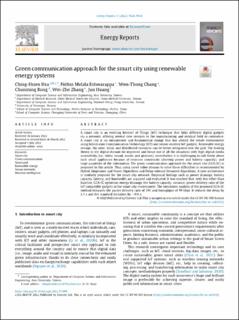| dc.contributor.author | Hsu, Ching-Hsien | |
| dc.contributor.author | Eshwarappa, Nithin Melala | |
| dc.contributor.author | Chang, Wen-Thong | |
| dc.contributor.author | Chunming, Rong | |
| dc.contributor.author | Zhang, Wei-Zhe | |
| dc.contributor.author | Huang, Jun | |
| dc.date.accessioned | 2023-03-21T12:20:19Z | |
| dc.date.available | 2023-03-21T12:20:19Z | |
| dc.date.created | 2022-08-23T13:55:52Z | |
| dc.date.issued | 2022 | |
| dc.identifier.citation | Hsu, C. H., Eshwarappa, N. M., Chang, W. T., Rong, C., Zhang, W. Z., & Huang, J. (2022). Green communication approach for the smart city using renewable energy systems. Energy Reports, 8, 9528-9540. | en_US |
| dc.identifier.issn | 2352-4847 | |
| dc.identifier.uri | https://hdl.handle.net/11250/3059532 | |
| dc.description.abstract | A smart city is an evolving Internet of Things (IoT) technique that links different digital gadgets
via a network, offering several new services to the manufacturing and medical field to commerce.
A smart city is an omnipresent and fundamental change that has altered the whole environment
using Information Communication Technology (ICT) and sensor-enabled IoT gadgets. Renewable energy
storage, the solar, wind, and distributed resources can be better integrated into the grid. The leading
theory in the digital domain for improved and broad use of all the situations with high digital media
accessibility (i.e., video, sound, words, and pictures), nevertheless it is challenging to talk freely about
such small appliances because of resource constraints (starving power and battery capacity), and
large quantities of the information. The green communication approach for the smart city (GCA-SC) is
proposed in this article. Thus, using saved video streams to solve these difficulties is recommended by
Hybrid Adaptation and Power Algorithms and Delay-tolerant Streamed Algorithms. A new architecture
is similarly proposed for the smart city network. Empirical findings such as power drainage, battery
capacity, latency, and bandwidth are acquired and evaluated. It was reached that, with less effort than
Baseline, GCA-SC optimises energy drainage, the battery capacity, variance, power delivery ratio of the
IoT compatible gadgets in the smart city environment. The simulation analysis of the proposed GCA-SC
method enhances the packet delivery ratio of 39% and throughput of 99 kbps. It reduces the delay by 2.5 s and the standard deviation by −0.9 s. | en_US |
| dc.language.iso | eng | en_US |
| dc.publisher | Elsevier | en_US |
| dc.rights | Navngivelse 4.0 Internasjonal | * |
| dc.rights.uri | http://creativecommons.org/licenses/by/4.0/deed.no | * |
| dc.title | Green communication approach for the smart city using renewable energy systems | en_US |
| dc.type | Peer reviewed | en_US |
| dc.type | Journal article | en_US |
| dc.description.version | publishedVersion | en_US |
| dc.rights.holder | the authors | en_US |
| dc.subject.nsi | VDP::Teknologi: 500::Informasjons- og kommunikasjonsteknologi: 550 | en_US |
| dc.source.pagenumber | 9528-9540 | en_US |
| dc.source.volume | 8 | en_US |
| dc.source.journal | Energy Reports | en_US |
| dc.identifier.doi | 10.1016/j.egyr.2022.07.009 | |
| dc.identifier.cristin | 2045390 | |
| cristin.ispublished | true | |
| cristin.fulltext | original | |
| cristin.qualitycode | 1 | |

